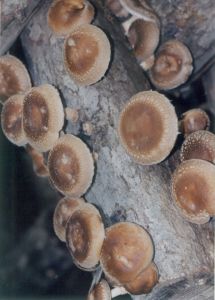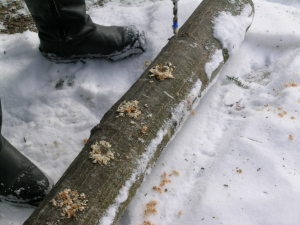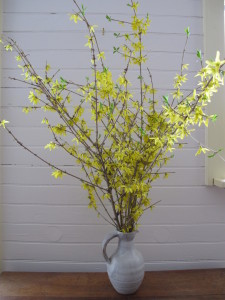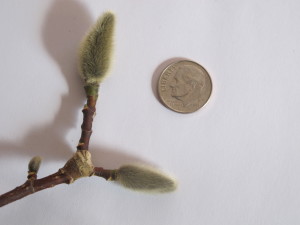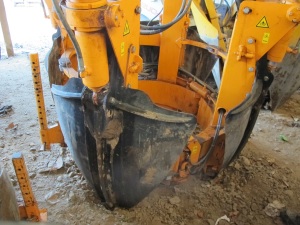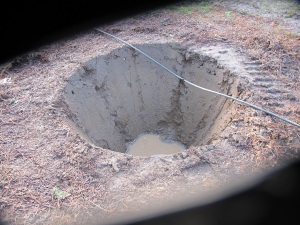Growing Mushrooms
I’ve been growing mushrooms outdoors on logs for about 20 years. I’ve done this by inoculating logs with little wooden plugs called plug spawn that I purchased and inserted into holes I drilled in the logs. Then I let them develop in the shade of a hemlock tree where they generally produce mushrooms in a year or less. Pretty easy. The best time to cut logs for growing mushrooms is late winter or early spring when the sap begins to run, so I am thinking about getting some logs soon and starting another batch. After all, there isn’t much else I can do in the garden for months.
The first step in the process of growing mushroom is finding logs that are appropriate for the mushrooms you want to grow. I have used oak and poplar for growing shiitake mushrooms, but according to Paul Stamets’ book, Mycelium Running: How Mushrooms Can Help Save the World, almost any deciduous tree species is fine for shiitakes, the mushrooms I have grown in the past. Pine, hemlock and other conifers are not recommended.
The logs you plan to use to raise shiitakes or other mushrooms need to be fresh. If you were to go in the woods and find a downed tree, it probably would already have fungi growing in the wood (mushrooms are the fruiting bodies of fungi). So you need to cut down a living tree (or better yet, have a person skilled with a chain saw cut it down for you). Or call up someone who sells firewood and explain what you want: logs 3 to 4 feet long and 4 to 8 inches in diameter that are freshly cut.
In the past I have most often inoculated poplar logs because the trees are fast growing, and I always have some ‘volunteers’ that need to be removed. Oaks are the species most commonly colonized by shiitakes in their native habitat of Japan, and produce for a longer time than poplar, but take longer to produce their first flush of mushrooms – up to 14 months. And they are a tree species I value, so it’s harder to sacrifice one.
I learned from Mycelium Running that not just shiitakes can be raised on logs. These species will also work, and are available from Stamets’ web site, www.fungi.com: Reishi, Maitake, Lion’s Mane, Pearl, Blue and Phoenix Oyster, Chicken of the Woods and Turkey Tail.
So how do I inoculate my logs? Using a 5/16-inch drill bit, I drill lines of holes about 8 inches apart from one end to the other. Then I drill another row of holes 4 to 6 inches from the first row. I stagger the holes so they don’t line up next to each other, from row to row. Then, with a hammer, I tap in the spore plugs that I have purchased. The holes should go a bit deeper into the wood than the length of the plug.
Finally, I melt some food grade wax (or natural bee’s wax) and paint the ends of the plugs. The wax prevents insects and bacteria that might consume the inoculant before the mycelium (fungal roots) extend and colonize the log. I have also tried inserting thimble spawn, which is made out of sawdust and has an attached Styrofoam cap. I find these are less satisfactory, as the caps do not always stay attached.
Paul Stamets is a self-avowed mushroom freak. He loves everything about them, and has found ways to grow edible and medicinal mushrooms, starting from wild harvested mushrooms. He describes several interesting ways of growing mushroom that I have not tried, but might this summer. Obviously I will only use mushrooms for propagation that I have had positively identified by a mushroom expert – some mushroom are deadly poisonous.
He describes inoculating piles of wood chips, burlap bags of wood chips and layers of cardboard, starting with what he calls “stem butts” from wild mushrooms. He digs up some of the root-like structures attached to the mushroom, along with the mushroom, and then cuts the edible portion off an inch or so above ground level. This “stem butt” is then put into a pile of woodchips or between layers of moist cardboard. The fungi quickly colonize the substrate, producing mycelium that will, when moved to an appropriate substrate, produce mushrooms.
Stamets’ book also describes how to start mushrooms by placing the stem butts into burlap bags of fresh wood chips. He notes that the chips should be free of wild spores, a problem if you just grab chips from a pile of wood chips that has been around for some time.
Finally, and this idea really grabs me, Mycelium Running suggest that you can inoculate stumps with plug spawn right after a tree has been cut down. This allows you to produce edible mushrooms in what is otherwise a spot unfit for planting (unless you dig out the stump, which is a lot of work). He inoculates stumps on their tops, into sapwood, in a ring around the periphery. Stamets notes that stumps take longer than logs or wood chips to first produce mushrooms, but produce for years longer.
My garden is deep in snow. Sigh. But I could buy a mushroom kit that is ready to produce mushrooms indoors, or spawn that I could use to inoculate logs once the cold of winter has passed.
Henry is the author of 4 gardening books and a children’s fantasy-adventure. His Web site is www.Gardening-Guy.com.
Mid-Winter Blahs
I’ve been hearing from friends who are sick of winter. We’re only about half way done with it, but we haven’t had a break – no January thaw this year – and the snow keeps building up. I’ll have to admit that I’m a little tired of shoveling and paying to get my roof cleared. So what can a gardener do? There’s plenty.
First, plant something. Nothing makes us gardeners feel better than planting (unless it’s picking peonies, which we can’t do yet). One of my favorite tricks is to sprinkle poppy seeds on the snow above a flower bed. These seeds are tiny and black, and the sun heats them enough to melt through the snow in the course of the winter. And although the germination rate will be low, I save seeds and have plenty. So it doesn’t matter if only a few find a nice crack in the soil and grow, come summer.
This weekend I will dig out my potting soil and trays and plant some onion seeds indoors. Onions take a long time to grow, so I like to start seeds in February, or early March at the latest. For a long time I just planted onion sets – dry, diminutive onions that are sold to start new onions. But then I learned that one can buy – or start from seed and then transplant – small green onion plants. I find that these plants are more vigorous.
If you don’t want to go through the trouble of raising your own onion plants, some seed catalogs will sell the plants at the appropriate time – but those are a lot more expensive than doing your own from seed.
And it’s not too early to cut branches for forcing. I have cut forsythia and magnolia branches, and will make a trip on my snowshoes to the wetland where pussywillows grow. All three – and others, like quince and apple – can be made to bloom inside the house. Just cut stems and put them in a vase with water.
Forsythia is, in my view, an old fashioned plant. My grandfather had a huge patch of forsythia growing as an island in the lawn. It separated his old 1860’s farmhouse from the vegetable garden. They grew tall and dense. I don’t know if he planted them when he bought the place in the 1920’s, or if they were already there. I suspect he planted them.
There must have been a dozen forsythia plants or so, planted in a double row about 10 feet apart. By the time I came along they created a secret hiding place in the middle between the two rows. My sister and I would crawl into the interior of the patch and we were totally hidden from adult view. A fine hiding place it was.
Grampy lived in Spencer, Massachusetts where winter temperatures probably never went much below zero. But living in the cold north, where we see minus 10 to 25 degrees for night after night, means that when I bought my place in 1970, forsythia was not a good option. Yes, it would survive, but the flower buds would be killed by cold temperatures unless buried by snow. I know, I tried.
Hybridizers kept trying different crosses – hybrids- and finally developed plants good for Zone 4 (with temps as low as minus 30). The late plantsman Paul Joly (here in Cornish, NH) developed one variety, ‘New Hampshire Gold’. Other good ones include ‘Meadowlark’, ‘Vermont Sun’ and ‘Northern Gold’. All those were created just with old fashioned breeding techniques, no genetic engineering.
I love cutting magnolia stems for forcing, even though it takes a long time to get the blossoms to open. I love them because the buds are fuzzy and big, sort of like pussywillows on steroids. I have a mature Merrill magnolia that is my favorite tree. It blooms every year on my birthday in late April, it has green glossy leaves all summer, and it has fabulous fuzzy flower buds that I can look at (and that make me smile) all winter. Fabulous plant. If I were sentenced to live in exile on an island and could bring just one tree, it might well be a magnolia (though an apple tree would be in strong competition).
I usually wait until late March to cut apple branches for forcing because that is when I start pruning apple trees. If you want the stems to bloom, you need to pick mature branches, not those young whips called water sprouts. Those straight stems look great in a vase, but will only produce leaves. To get blossoms, you must have fruit spurs, which are 3 to 6 inch branches – spurs – attached to old wood. You will notice fruit buds, which are larger than leaf buds, near the tip of fruit spurs. These will produce a cluster of blossoms, and leaves, too.
Meanwhile, we should all be thankful for all the snow we’ve had. It protects our perennials, the tender ones, from severe temperatures. I once dug down through 4 feet of fluffy snow and probed the soil in my vegetable garden with a thermometer. Just a couple of inches down the soil was 37 degrees. And only the top inch or so was even frozen. Barren winters, with no snow, are much harder on our plants, even if not so cold as this year.
So bundle up, put on your earmuffs and scarf, and go cut some stems and put them in water. Before too long, you’ll have spring in your house – even if it’s still snowing outside.
Henry Homeyer lives in Cornish Flat, NH. He is the author of 4 gardening books and a children’s fantasy-adventure about a boy and a cougar called Wobar and the Quest for the Magic Calumet. His web site is www.Gardening-Guy.com.
Winter Planning: What Size Tree to Buy?
The snow is deep, the temperatures well below freezing. It’s a good time to think about what projects to undertake this year. My friend Evan Schneider, who was in the Peace Corps with me in Cameroon, recently bought a house in Portland, Oregon. He and his wife are retired and realized that whatever landscaping they do, they don’t want to wait 20 years for a shade tree to actually produce enough shade for the two of them to sit in the shade all afternoon reading good books.
In general, I buy the smallest tree available, not the largest. I know that a small tree loses a smaller percentage of its roots when it is dug up for transplanting. Or if it has been growing in a plastic tub, I figure the less time it is in that tub, the less time the roots have to encircle the pot and get tangled. So I was surprised that they had purchased a thirty-foot tall maple tree, and had it installed. I visited them recently, and saw that the tree seems to be thriving.
Evan took me to meet the people who had done the job. The company is called Big Trees Today, in Hillsboro OR, and they specialize in growing big trees in the ground, and then digging them up and installing them. Dan Hickman, the owner, is now in his mid-thirties and is selling some trees that he planted when he was in junior high school (and working for his dad).
Dan said they generally buy small, bareroot trees, plant them in the ground, and then move them 3 times before selling them. After a tree is about 2 inches diameter it is dug up and moved. Digging it up means that the roots are severed, which stimulates new roots to grow and to branch out from the older roots. Then when the trunk is about 5 inches in diameter, it is dug up and moved again. Finally at 9 inches in diameter it is moved for the final time before it is sold. Depending on the kind of tree and how fast it grows, it might be root pruned again without digging it up – by digging down and severing roots.
I once moved a crab apple tree for a woman who had planted it when her son was born. She and her family were moving, and wanted to move the tree, even though her son was, by then, twelve years old (I think). I told her I could do it as a two-step process: First, I would cut the roots along a dotted line about two and a half feet from the trunk. I alternated thrusting the shovel deep into the soil and leaving a shovel-width undisturbed. I did that in the fall, I believe, and then moved the tree the next year. When it was time to dig it up, I dug around the tree three feet from the trunk. That way the previously severed roots had been given time to fork out and grow new feeder roots which were largely undisturbed when I moved it.
Most commercial firms that move trees have a special tractor-mounted tool called a tree spade. It is fitted around the tree and several big blades are hydraulically powered to slice deep into the earth creating a root ball that is shaped a bit like a huge ice cream cone (though not as pointy).
Dan Hickman told me that it is important that the root ball not fall apart during the digging, the transporting, or the planting. His firm is located where the soil is high in clay, which helps the root ball stick together, especially if kept moist. But they also wrap the root ball, first in an open wire cage, then in burlap.
I have seen trees with root balls wrapped in synthetic burlap, which must be removed at planting time. I once dug up a tree that was 7 years old and was not growing well, only to find that its roots were encased in burlap that had not broken down. Dan Hickman said the burlap they use disintegrates in 3 to 4 months, and they leave it in place. Only after it is planted do they cut away any burlap they can at the soil surface. Me? I’ve always removed the burlap.
I asked Dan what was the biggest tree he ever moved. He told me that they once moved an historic camperdown elm (Ulmus glabra ‘Camperdownii’) that was 106 years old but in the way of an upcoming building project. It had a rootball 16 feet wide and it weighed 73,000 pounds – over 36 tons! He and his crew root pruned it in the spring, and then dug it up and moved it in the fall. It is doing fine.
What else should you know about buying a big tree? Find a company that has plenty of experience. A company that has invested in a tree spade is probably a good bet, though it can be done by hand. Be sure to have the tree planted at the right depth – you will want it to sit with its trunk flare exposed, not buried.
Set up a watering system so that your big tree never gets thirsty. Digging a big tree severs roots, even if it has been root pruned and has a compact root system. A transplanted tree has fewer root hairs to pick up water and minerals. It makes sense to use a timer that will turn on your watering system on a schedule. You can use a soaker hose or an irrigation system with emitters to deliver the water. It will require more water in the heat of August than in the spring or fall, so will have to adjust it accordingly.
Finally, create a “donut” of bark or wood chips around the tree, covering the roots, but not touching the trunk. Mulch will keep down weeds and grass, and keep those dudes with weed whackers away from the trunk. You don’t want the bark damaged, and string trimmers or lawnmowers can be lethal.
So I’ve re-thought my position about planting big trees. I’m not exactly a spring chicken anymore, so if I want to see another mature tree on my property, I’ll consider buying a big tree. And maybe even having an expert – with the right tools – install it.
Henry lives in Cornish Flat, NH and is a UNH Master Gardener. His Web site is www.Gardening-Guy.com. He is the author of 5 books.
Being Healthy: Growing and Eating Food That is Safe
We’ve come a long way from the day when most families grew their own vegetables and had a few chickens and a cow. From the day when fertilizer was manure of some sort, and when bug control was largely picking off the slugs and bugs. My mom (Elfrieda Lenat, 1916-2009) grew up like that. As a boy we grew a lot of our own organic vegetables, but lacked the farm animals- even though I longed to raise some chickens.
Since my mom’s youth much has changed at the grocery store, too. We are buying more processed foods, foods that contain corn and soy products grown with genetically modified organisms (GMO’s). We are buying produce that has been sprayed with pesticides and grown with chemical fertilizers. The fresh fruits and vegetables from the
store are, we assume, safe to eat. This is America, after all, where our government looks out for us.
But the government is not able to test every box of strawberries or bag of apples to see if there are harmful chemicals in the fruit. According to recent government statistics, the Department of Agriculture tests about one tenth of one percent of fresh produce coming into the country for chemical residues, and less than one percent of our American-grown fruits and vegetables.
We all know that any food identified with a green sticker that says USDA certified organic does not include genetically modified ingredients, and that any sprays have been approved by OMRI, the organic certifying board – though some can still be strong natural pesticides from plants, for example. What about “natural” or “all natural” labels? They have no regulatory meaning. Our own home grown food? If you don’t use chemicals anywhere on the property, those are safe.
But organic food is more expensive, and sometimes we have to make choices. According to the non-profit organization, Green America, the 10 fresh vegetables and fruits you should buy organic at the grocery store are: apples, bell peppers, celery, cherries, imported grapes, nectarines, peaches, pears, potatoes, raspberries, spinach and strawberries. Save that list, and bring it with you the next time you go to the grocery store – or memorize it. And you can trust your local farmer using an Integrated Pest Management program (IPM) to have safe, fresh food in season, too. Just ask about IPM at the farm stand next summer.
So for example, conventional strawberries from California are big and beautiful – and available almost all year round. But the California growers have lobbied successfully with our government, and they have a loophole in the law. They are allowed to use methyl bromide, a fumigant that they pump into the soil, and then seal it in with a layer of plastic. This kills every living thing, including the fungus called Fusarium wilt that can wipe out a crop of strawberries. Most other countries have banned methyl bromide for its toxicity and for what it does to our ozone layer. But money talks, and lobbyists prevail. Me? I won’t buy strawberries from California, or eat them even if they’re served as a garnish out of season (meaning they are probably from California.)
But let’s go back to corn and soy, which are found in virtually all processed foods from sodas and chips to frozen pizza and turkey pot pies. Virtually all non-organic corn and soy is GMO and is resistant to a chemical herbicide, glyphosate, commonly sold as ‘Roundup’. Roundup makes farming easier and cheaper – by eliminating weeds. So corn and soy fields are sprayed with glyphosate to kill weeds, and the grains are not harmed. But glyphosate is taken up by the corn and soy, so it ends up in our food.
The Environmental Protection Agency (EPA) considers glyphosate safe to use, and the USDA not monitor glyphosate levels in food. Nor does the manufacturer have to say what the “inert” ingredients are in the product, as this information is consider a trade secret. But inert does not necessarily mean inert to us or the environment. Inert to the EPA just means those ingredients do not play a role in killing weeds. Since we don’t know what they are, I want to avoid them.
But here is what makes me most nervous about ingesting glyphosate: even though it does not affect my metabolism directly, it does affect the bacteria which play an important part in my good health. The same metabolic pathway that allows Roundup to kill weeds is an important metabolic pathway in bacteria. So I won’t use glyphosate too kill weeds, and try to avoid food that has been treated with it. That means avoiding processed food.
What about conventional meats, milk and eggs? Glyphosate is showing up there, too, because animals are fed GMO corn as feed – which is treated with glyphosate. So unless you buy organic meats or know that your local farmer is not using feed with GMO corn in it, you can ingest glyphosate from your meat. If you buy your meats at your local farmers market, you can ask your farmers what they feed their animals.
So, as we head into the season for starting seedlings indoors, think about expanding your vegetable garden to include more food that you can store for winter use – or just enjoy fresh off the vine in summer. If you grow your own vegetables, you can insure that your food is safe – and chemical free. I do it, and it feels good.
Henry’s web site is www.Gardening-Guy.com. He is the author of 4 gardening books and a fantasy-adventure for children about a boy and a cougar.



